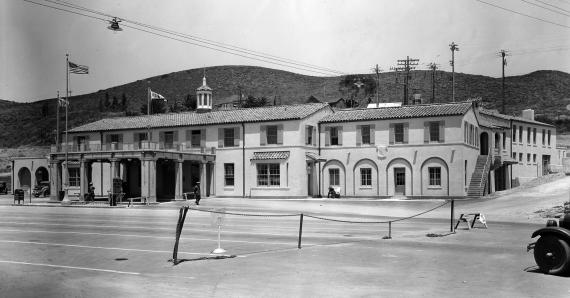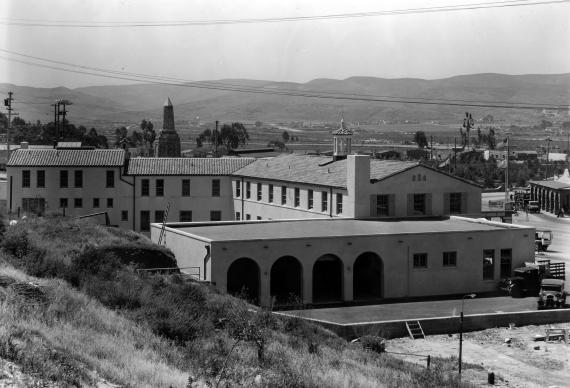San Ysidro’s Historic Customs House and the Tale of Two [Border] Cities
By Javier Fernandez

With over 480 historical buildings in our inventory, GSA is the proud steward of the nation’s public buildings architectural heritage. This May, as we observe National Preservation Month, we also reflect on GSA’s and the federal government’s history in San Ysidro and celebrate our historic Customs House at the port. Region 9 will soon be completing a 10-year modernization and expansion project at the San Ysidro Land Port of Entry. Along with the expanded pedestrian processing facilities and northbound/southbound lane improvements, the renovation of the historic Customs House underscores GSA’s commitment to serving the community and aiding our federal agency tenants fulfill their important missions. It also demonstrates our commitment to preserving our architectural past for future generations and erecting buildings meant to last and provide the best value to the American taxpayer.
But what do we know about San Ysidro’s historic Customs House and the role it played along the U.S. - Mexico border?
In many ways, the history of federal border inspection facilities in San Ysidro mirrors the region’s rich history and reflects the strong economic ties between the two border cities. San Diego-Tijuana is a region that has seen three transfers of power in the last 250 years and where change and growth appear to be the only constants. Similarly, the San Ysidro Land Port of Entry has changed and grown over the decades to better suit the needs of the binational community and those of the federal agencies who manage inspection operations at the port.
Rancho Period & Early Border History
Following Mexico’s independence from Spain, San Diego became part of the newly independent Mexican Republic in 1822. Eight years later, the Presidio of San Diego’s commandant, Santiago Arguello Moraga, was granted a 10,000 acre ranch called Rancho Tia Juana, which was located in the vicinity of what is now San Ysidro and Tijuana. The Rancho Tia Juana region saw little growth or development until the Treaty of Guadalupe Hidalgo in 1848, which was signed following the U.S. - Mexican war and formally established the newly created U.S.-Mexican border south of San Ysidro.
Following the connection to the Southern California Railroad in 1885, the City of San Diego experienced an unparalleled period of population growth known as the “Great Boom” between 1885 and 1887. As a result, a number of homesteads began to appear along the rail line in San Ysidro, or Tia Juana City as it was known at the time. Tia Juana City had grown from a single street of wood framed buildings to one with its own drug store, salon, hotel and boot shop. While none of the original Tia Juana City buildings remain, the site is now home to the Las Americas Premium Outlets in San Ysidro.
It was around this time period that the U.S. began better defining their southern border with Mexico and by the mid 1860s, 258 temporary markers were erected along the 1,200 mile U.S. - Mexico border between San Diego and Brownsville, Texas. In San Ysidro, the border remained unfenced until 1910, when barbed wire fencing was installed from the Pacific Ocean to Otay Mountain. However the border in San Ysidro had an established federal presence already with the first officers patrolling the American side of the border in San Ysidro as early as 1871. Additionally, the first customs facility (no longer existing), a one story customs house, was built in Tijuana in 1873
Border Town Development

Starting at the end of 1917, U.S. immigration authorities began to require passports to cross the border only to receive orders a few years later to completely close the border as a precaution during World War I. The border reopened in 1920 and travel between San Ysidro and Tijuana resumed for tourists and residents. Prohibition further fueled cross border travel with the recent passage of the 18th Amendment, which established the prohibition of “intoxicating liquors” and led to fight promoters, gambling establishments, alcohol establishment proprietors and other businesses to move their operations to Tijuana and Mexicali.
The 1920s and 1930s saw a dramatic growth in the gambling and entertainment sectors in Tijuana. American tourists visiting San Diego often traveled through San Ysidro to Tijuana for vacation. Natural mineral baths boasting health benefits were an early tourist attraction that was soon rivaled by other tourist activities such as bullfights, cockfights, and horse races. By 1915, 500 residents called San Ysidro home and were comprised primarily by Americans who resided in San Ysidro and crossed to Tijuana to work in the city’s race tracks, bars, and casinos.
By the late 1920s, cross border traffic had grown to such a point that the original one-story customs house was no longer sufficient to accommodate the increased volume of travelers and a new, larger replacement facility became necessary. The U.S. Department of the Treasury purchased the last five parcels of land on the border in June 1931 and the following year construction drawings were completed by architect James A. Wetmore. Wetmore’s design for the new San Ysidro Customs House was that of two-story Spanish Revival style building. The stucco exterior features terra cotta trim on the exterior walls, wood windows and doors and ceramic tile roofs display a notable faithfulness to its Spanish antecedents and reflect the Treasury Department’s penchant for eclectic revivalist architecture during this era.
Following the completion of the new Customs House, the San Ysidro Land Port of Entry began twenty-four hour operations for the first time in 1933, even while the number of border crossings decreased largely in part to the Great Depression and the repeal of the 18th Amendment that effectively ended Prohibition. While this damaged San Ysidro’s tourism industry significantly, the small but resilient community shifted focus to small-scale farming operations in the years leading up to and following World War II.
San Ysidro Post World War II
Following World War II, San Ysidro remained an agricultural community even as cross border traffic and tourism related activities once again increased. Much of this economic activity and increase in border crossing during the war and postwar period was due in part to the Bracero Program which existed from 1942 to 1964. Taking its name from the Spanish word “bracero”, which means “manual laborer” or “one who works with his arms”, the program allowed Mexican laborers the opportunity to temporarily work in American farms and ranches to make up for the labor shortage due to the war. While no records detailing the number of braceros that passed through San Ysidro survive, we do know that annual border traffic had reached 4.5 million by 1945 and continued to increase to 7.5 million by 1948.
San Ysidro Port Expansions
Recognizing the vital role border crossing activities played in the greater San Diego - Tijuana region, the City of San Diego moved to annex San Ysidro in 1957. Many San Ysidro residents were unhappy with the annexation and made an unsuccessful bid to reverse the decision in 1973. This time period also saw many changes in the community; demographically, the population shifted from being primarily Anglo to Mexican in the 1960s and border wait times began to increase as the existing border infrastructure could no longer accommodate the increasing crossing volume. As a direct result, GSA began an ambitious port modernization and expansion project in the 1970s and by 1988 San Ysidro had become the busiest land border crossing in the U.S.
In 2009, GSA began a multi-year, three phase port modernization and expansion project to accommodate a projected 87% growth in vehicle traffic and to better meet the changing needs of the tenant agencies and the traveling public. The project will be complete in winter 2019.
For more information about the San Ysidro LPOE project visit: www.gsa.gov/sanysidro.

 U.S. General Services Administration
U.S. General Services Administration